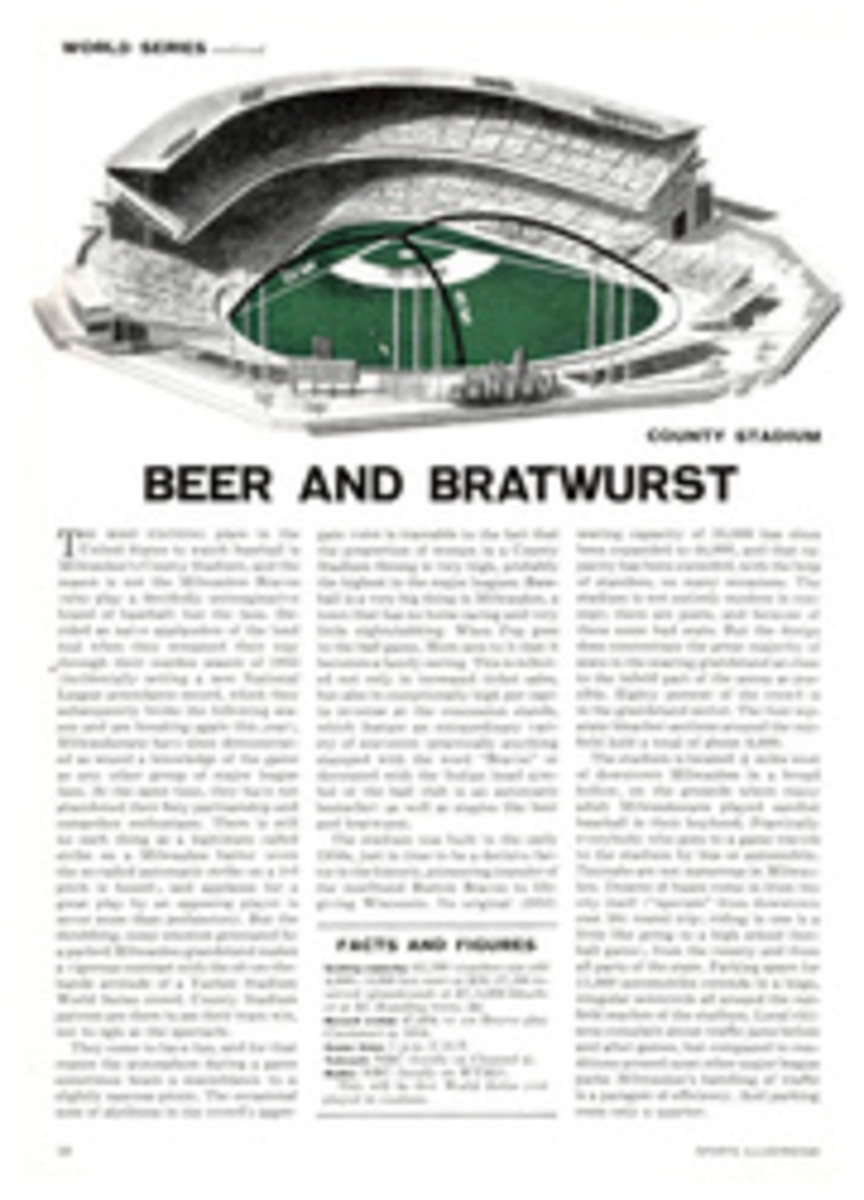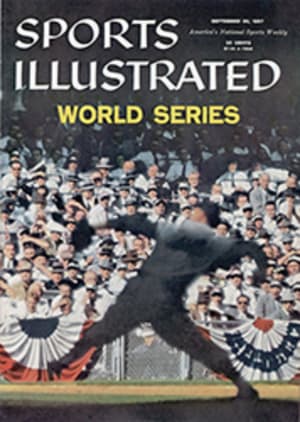
BEER AND BRATWURST
COUNTY STADIUM
The most exciting place in the United States to watch baseball is Milwaukee's County Stadium, and the reason is not the Milwaukee Braves (who play a decidedly unimaginative brand of baseball) but the fans. Derided as naive applauders of the loud foul when they screamed their way through their maiden season of 1953 (incidentally setting a new National League attendance record, which they subsequently broke the following season and are breaking again this year), Milwaukeeans have since demonstrated as sound a knowledge of the game as any other group of major league fans. At the same time, they have not abandoned their fiery partisanship and outspoken enthusiasm. There is still no such thing as a legitimate called strike on a Milwaukee batter (even the so-called automatic strike on a 3-0 pitch is booed), and applause for a great play by an opposing player is never more than perfunctory. But the throbbing, noisy emotion generated by a packed Milwaukee grandstand makes a vigorous contrast with the sit-on-the-hands attitude of a Yankee Stadium World Series crowd. County Stadium patrons are there to see their team win, not to ogle at the spectacle.
They come to have fun, and for that reason the atmosphere during a game sometimes bears a resemblance to a slightly raucous picnic. The occasional note of shrillness in the crowd's aggregate voice is traceable to the fact that the proportion of women in a County Stadium throng is very high, probably the highest in the major leagues. Baseball is a very big thing in Milwaukee, a town that has no horse racing and very little nightclubbing. When Pop goes to the ball game, Mom sees to it that it becomes a family outing. This is reflected not only in increased ticket sales, but also in exceptionally high per capita revenue at the concession stands, which feature an extraordinary variety of souvenirs (practically anything stamped with the word "Braves" or decorated with the Indian head symbol of the ball club is an automatic bestseller) as well as staples like beer and bratwurst.
The stadium was built in the early 1950s, just in time to be a decisive factor in the historic, pioneering transfer of the moribund Boston Braves to life-giving Wisconsin. Its original (1953) seating capacity of 35,000 has since been expanded to 44,000, and that capacity has been exceeded, with the help of standees, on many occasions. The stadium is not entirely modern in concept; there are posts, and because of them some bad seats. But the design does concentrate the great majority of seats in the soaring grandstand as close to the infield part of the arena as possible. Eighty percent of the crowd is in the grandstand sector. The four separate bleacher sections around the outfield hold a total of about 8,000.
The stadium is located 3 miles west of downtown Milwaukee in a broad hollow, on the grounds where many adult Milwaukeeans played sandlot baseball in their boyhood. Practically everybody who goes to a game travels to the stadium by bus or automobile. Taxicabs are not numerous in Milwaukee. Dozens of buses come in from the city itself ("specials" from downtown cost 50¢ round trip; riding in one is a little like going to a high school football game), from the county and from all parts of the state. Parking space for 11,000 automobiles extends in a huge, irregular semicircle all around the outfield reaches of the stadium. Local citizens complain about traffic jams before and after games, but compared to conditions around most other major league parks Milwaukee's handling of traffic is a paragon of efficiency. And parking costs only a quarter.
ILLUSTRATION
MATT GREENE
315 feet
320 feet
402 feet
FACTS AND FIGURES
Seating capacity: 43,500 (standees can add 4,000): 8,000 box seats at $10; 27,500 reserved (grandstand) at $7; 8,000 bleacher at $2. Standing room: $4.
Record crowd: 47,604 to see Braves play Cincinnati in 1956.
Game time: 1 p.m. C.D.T.
Telecast: NBC (locally on Channel 4).
Radio: NBC (locally on WTMJ).
This will be first World Series ever played in stadium.

